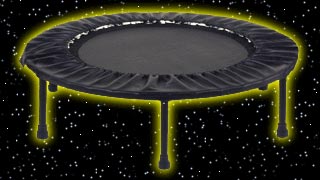I've written this page mainly for those technical people - Rebounder Tensile Strengths:
For those that are planning on using the rebounder every day or who weigh close to the maximum yield strength of the spring limit, it's important to know so you don't have to change springs every 2 years as the springs lose its initial tension.
A spring that has low carbon steel will stretch out more quick (have more yield but not yield strength) while springs that have more coils may last longer and wider but they don't generate as much G force. The goal is to use the least amount of each rebounder springs to get the bounce with the least amplitude (staying close to the mat). The Cellerciser has the longest spring with more coils than any rebounder I've tested but it has 3 tensile strengths in each spring so you really aren't using the whole spring, just the spring based on your weight.
A good spring should have a Tensile strength of at least 55000 PSI (thats super high carbon) and the yield strength should be slightly lower at 50,000 PSI. When the number goes higher than the tensile number the spring gets less rigid. It is good to know if the spring you are using is American steel or imported steel. Some springs have raw untreated steel while US steel is known for its smoothness. The cheap import springs are galvanized and have a very marbleized feel. Many of the cheaper springs are zinc coated too so they wont rust. A Cellerciser spring, for example, won't rust even if put in salt water. If the spring is super shiny, you can tell what type it is usually. Digitally tempered springs all weight the same as they don't have air bubbles in the steel. These air bubbles on analog tempered springs give it less tensile strength. Cellerciser is the only company right now that is digitally tempering their springs. Their springs cost about 3 times as much as most of the other springs on my site.
Many of the cheaper springs that have high tensile strength right when you first buy it but then loses it quickly over the first 2 years are the chrome made springs. They don't actually break easily but it's the tensile strength that goes away fast.
Rebounder springs that have very few coils like on the Lymphaciser, people think are less quality as they are very light weight and tiny. Those springs are made with ONLY enough coils to support the Health Bounce and ONLY that. They are very high gauge and tensile strength is off the charts. With the Lymphaciser, you don't get those deep bounces like with the opposite extreme rebounder, the Cellerciser. I get very little height when I bounce on the Lymphaciser and trying to jump high with a low coil spring might not be pleasant.
The tensile strength of the Cellerciser is the highest of all spring rebounders I've tried. They use music wire quality. Piano wire is the most expensive type to make springs out of unlike the hand drawn type. Only a few companies use music wire quality steel and they are usually imports models.
Music wire grade retains its tensile strength and yield much longer than any other spring type. It is hard for a spring with very high carbon content to break or snap.
The rebounder that I refer to having a low carbon content that have a soft bounce (which really becomes too soft to do the Health Bounce after 2 years), are the ones that are close to in size of a Cellerciser, but are tapered so they last a little longer. The Needak Rebounder gives more free bounces since the bounce is deeper. When doing the Health Bounce I look for the rebounder that gives me the fewest free bounces so I can stay lower to the mat. Free bounces are those bounces you get without using effort. A spring with high yield will be more likely to bottom out if you jump high and your heel hits the floor as the mat has too much yield. If someone is heavy, I recommend a super high tensile low coil spring like the Lymphaciser or if someone want a spring that is very long and doing high bounces and doesn't want to bottom out to the floor, the Cellerciser is my pick.
Note: Beware of rebounder springs that companies are mixing American steel with cheap import steel. When companies say they are "MADE IN THE USA", be cautious that its not the import steel made in the states.
Springs that are digitally tempered and cold formed are the best in springs. Cold steel that is the same gauge and same diameter of a NON-Cold formed spring is usually about 30% stronger in tensile strength.
If the spring from the raw steel is smooth (before it is coated) and not galvanized it will probably be a very high quality spring.
If you need help choosing a rebounder with the right tensile strength for your weight and type of bouncing you are going to do, take my rebounder quiz. Please make sure to let me know if you have a bad back or your main goal is doing the Health Bounce. Take my quiz here.
Take the
Take the
AVOID RIPOFF: DO NOT BUY ANY REBOUNDER BEFORE READING THIS
Beware of bogus rebounder reviews and fake comparison websites.
See the list of tricks rebounder companies use to trick you here.
1-877-354-3778
Open 7am till 11pm Eastern
Lymphaciser
LymphaticRebounding.com
Cellerciser
Bellicon
Needak
Rebound Air
URBAN
Lympholine
JUMP SPORT
Hexagonal
Bungee
Freedom Spring
1-877-354-3778
Open 7am till 11pm Eastern












